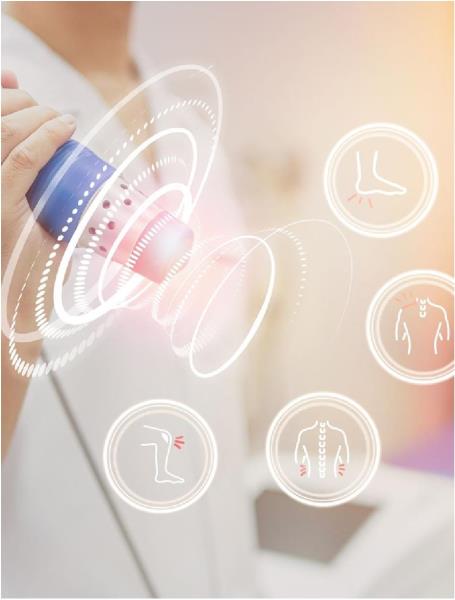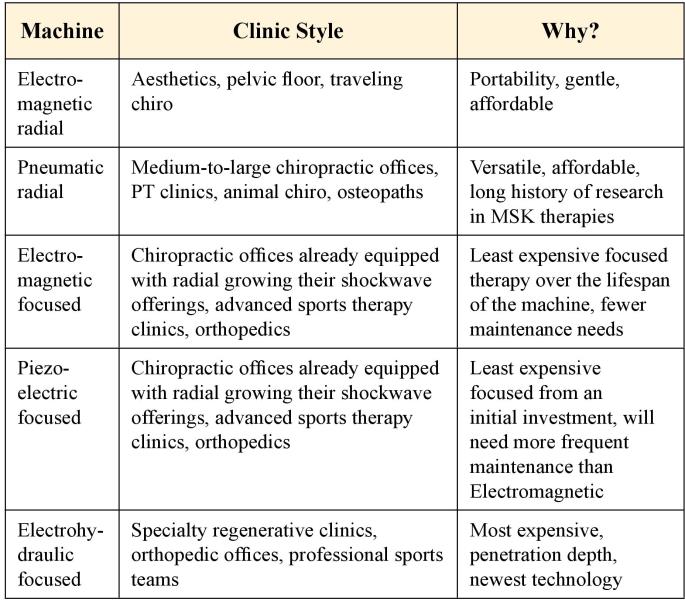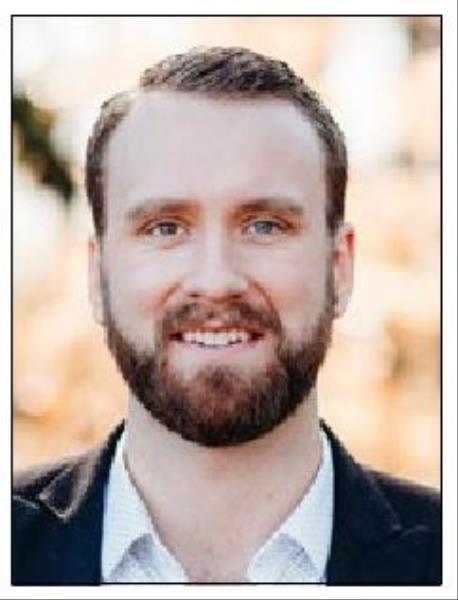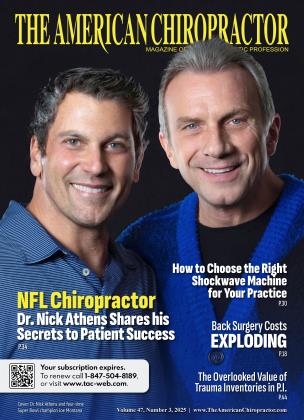
THE POPULARITY OF SHOCKWAVE THERAPY IN chiropractic offices has absolutely erupted in the last few years, and for good reason. The ability to help patients with complex musculoskeletal issues, tendinopathies, neuropathies, post-surgical joint restrictions, etc., makes it a very useful tool in the chiropractor’s toolbox. I tell my colleague chiropractors that if they only had one therapy tool to accompany their adjusting, shockwave is so versatile that it would eliminate the need for a room full of different modalities.
Okay, now you have decided that shockwave may be the next addition to your practice, but which one? How much should you spend? What is the difference between machines and brands in each category? Let this be a guide to help you make your decision or at least narrow it down to help you ask the right questions before purchasing.
You may be surprised to hear that there isn’t one answer or correct machine for every practice. As we know, very few chiropractic offices are the same. This is a wonderful thing most of the time, but it does pose some challenges when giving advice about which machine to recommend.
My practice is a cash-based family practice, and we implement shockwave in a different way than a lot of other practices using the same therapy. We have clients that are heavy-hitters in the personal injury (PI) world — some are very focused on sports rehab, some integrate with pelvic floor therapists, and others use shockwave for aesthetics. The list goes on and on.
The conversation with a prospective DC looking for a machine absolutely must start with a deep dive into their practice model to find the right machine for them. I will give a brief run-down on the types of shockwave therapy devices on the market and provide examples of practices where they are (usually) best suited. Hopefully, this will offer some clarity to the very confusing landscape of shockwave devices for sale.
Shockwave therapy is broken down into two main categories — radial shockwave and focused shockwave. Radial devices deliver energy in a dispersive manner, making them ideal for treating larger surface areas and superficial tissues. Focused devices, on the other hand, concentrate energy in precise, deep tissue regions, which can be beneficial for niche applications. Think of radial therapy as your shotgun and focused therapy as your sniper rifle — both useful tools that thrive in different ways.
After the division of radial and focused, we break therapies down into how the shockwave is produced. Every detail outside of that is basically just branding and marketing. Branding is important, don’t get me wrong. However, I am not here to tote one style or brand over another, just to help you find the type of shockwave machine that suits your practice.
So, in the radial category, you will find pneumatic and electromagnetic machines. Pneumatic machines are larger and more powerful, reaching an output of about 8BAR (translates to about 7 cm of effective penetration depth). For focused machines, you will see electromagnetic, electrohydraulic, and piezoelectric options. They all have similar penetration depth abilities (around 12 cm) but will differ in how the shockwave is created. We will explore all three options here to help support the possibility of adding focused shockwave therapy to your practice.
Radial shockwave devices are most commonly chosen for chiropractors and physiotherapists for economics, maintenance, ease of use, ability for staff to operate the machine, and long history of efficacy. Electromagnetic radial machines are smaller and less powerful; they usually stop at about 4 cm of effective penetration depth. Electromagnetic radial machines are common in aesthetics and pelvic floor therapy because of their power constraints, portability, and ease of use. These could also suit the traveling chiropractor who needs more portability than power.
Pneumatic machines have an easier time treating deeper scar-tissue-laden areas compared to electromagnetic ones. Thanks to almost double the power output, you will be able to treat a huge variety of chronic MSK injuries with pneumatic machines without a big jump in price from electromagnetic. Pneumatic radial machines are also easy to use, maintenance is infrequent and less expensive, and staff can usually perform the therapy.
Focused shockwave therapy is growing in popularity in the chiropractic profession thanks to more companies coming to market with focused therapy and the marketing efforts therein. There is definitely a place for focused shockwave devices, but it’s really important to make sure your office is prepared for it.
Because focused shockwave machines have an increased power output and depth of penetration, they are a more advanced risk classification (class 2 or 3) compared to radial. This can be an issue in some states regarding who is able to treat patients with the machine. Technicians, chiropractic assistants, massage therapists, and physical therapy assistants may not be legally able to perform focused shockwave. If the goal of your office is to hand off the therapy to staff, this may not suit you.
The economics of focused shockwave are also vastly different from radial. The initial investment is at least three to four times larger than a radial machine, maintenance is much more frequent, and it adds significant financial concerns for smaller practices. When you factor in these overhead costs, the amount you will have to charge patients also rises. Focused therapy prices seem to hover around $250 or more per session, while radial sessions are less than $100. For high-end sports therapy clinics, professional teams, orthopedic offices, and regenerative offices, focused therapy may be a good fit for that style of practice.
I would also recommend having a radial on hand to manage the 80 to 90% of issues that wouldn’t need the extra power/depth. That helps save the focused machine from needing as much maintenance and will extend the life of both machines. This is what shockwave clinics (offices that do nothing but shockwave therapy) are doing in the EU and Canada.
For example, if you use a Ferrari as your everyday home-to-office car, you will spend an additional fortune on maintenance by using it for something unnecessary. Instead, you could drive your Toyota Corolla for your commute and take the Ferrari out to the racetrack on weekends. If the finances allow it and your practice model suits it, by all means, consider a focused device.
In conclusion, the general breakdown of machines to their respective suitable clinic styles are as follows:

“If the finances allow it and your practice model suits it, by all means, consider a focused device”
I cannot stress the last step in the process enough, which is due diligence. There are different companies that make each of the different styles of machines, and it is important that the chiropractor calls and asks the right questions about the type of machine that suits their practice. Make sure you know what happens after you purchase by asking the following important questions:
• How is training handled?
• What is the setup process?
• What happens if my machine stops working?
• Do they have a loaner program when machines need service?
• Do they offer marketing help/clinic setup advice?
• What is the warranty?
• Am I allowed to do shockwave therapy in my state?
• Can my CA or technicians perform the therapy for me?
• Are they FDA cleared?
• What does maintenance cost every year?
• How many shockwaves until the handle needs replacing?
I believe there is a shockwave machine for every office, but it takes some time to find the best one to propel your practice forward and not just be an expensive dust collector. I sincerely hope this was helpful for any chiropractor looking to add shockwave to the practice. As a fellow shockwave provider and educator, I look forward to welcoming you all to the shockwave family!

Dr. Dan Ruitenbeek is a practicing chiropractor based out of Marietta GA. Dr. Dan is the co-owner of SWCA ( Shockwave Centers of America). With over 16 years of shockwave therapy experience, Dr. Dan and the SWCA team have been supplying machines and educating practitioners in over 750 offices throughout the US & Canada. You can contact Dr. Ruitenbeek at [email protected] or 561-3003444 Visit www.shockwavecenters.com for more information.
 View Full Issue
View Full Issue






